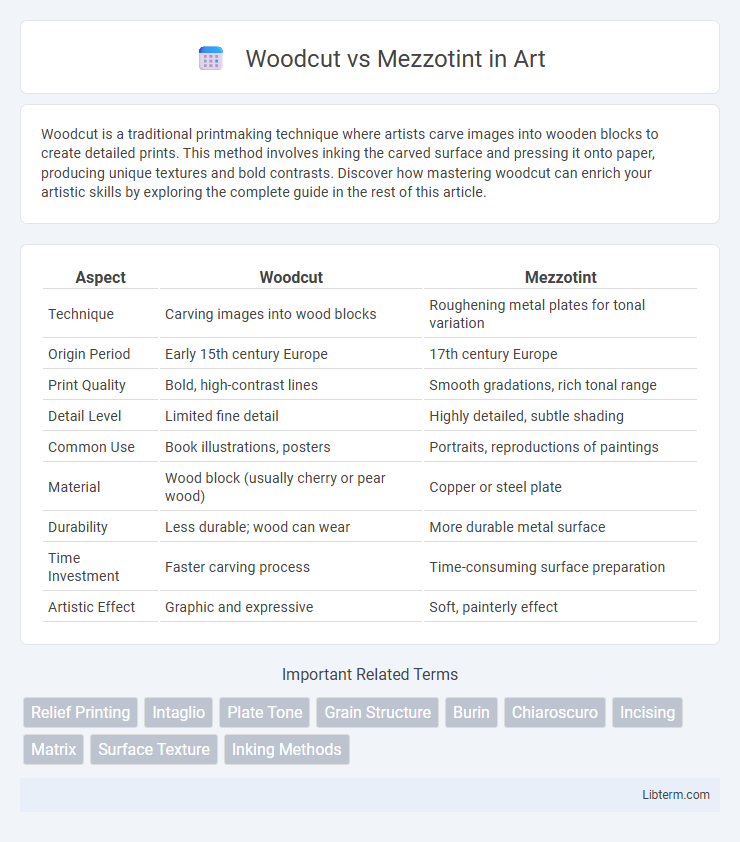Woodcut is a traditional printmaking technique where artists carve images into wooden blocks to create detailed prints. This method involves inking the carved surface and pressing it onto paper, producing unique textures and bold contrasts. Discover how mastering woodcut can enrich your artistic skills by exploring the complete guide in the rest of this article.
Table of Comparison
| Aspect | Woodcut | Mezzotint |
|---|---|---|
| Technique | Carving images into wood blocks | Roughening metal plates for tonal variation |
| Origin Period | Early 15th century Europe | 17th century Europe |
| Print Quality | Bold, high-contrast lines | Smooth gradations, rich tonal range |
| Detail Level | Limited fine detail | Highly detailed, subtle shading |
| Common Use | Book illustrations, posters | Portraits, reproductions of paintings |
| Material | Wood block (usually cherry or pear wood) | Copper or steel plate |
| Durability | Less durable; wood can wear | More durable metal surface |
| Time Investment | Faster carving process | Time-consuming surface preparation |
| Artistic Effect | Graphic and expressive | Soft, painterly effect |
Introduction to Printmaking Techniques
Woodcut and mezzotint are distinct printmaking techniques, each offering unique textural qualities and depths of tonal range. Woodcut involves carving an image into a wooden block, creating bold contrasts through raised areas that hold ink, while mezzotint uses a metal plate roughened with a rocker to produce smooth gradations from dark to light. These methods highlight the diversity of printmaking, with woodcut emphasizing graphic clarity and mezzotint excelling in rich, velvety tones.
What is Woodcut?
Woodcut is a relief printing technique where artists carve an image into the surface of a wooden block, removing the non-printing areas to leave the design raised. Ink is then applied to the raised surfaces and pressed onto paper, producing bold, high-contrast prints characterized by sharp lines and a textured grain. This method dates back to ancient East Asia and became a dominant printmaking process in Europe during the 15th century.
What is Mezzotint?
Mezzotint is a printmaking technique developed in the 17th century that allows for rich tonal gradations, achieved by roughening a metal plate surface to hold ink and then smoothing areas to create lighter tones. Unlike woodcut, which relies on carving away wood to produce bold contrast and lines, mezzotint provides a unique capacity for subtle shading and depth, making it ideal for reproducing paintings with intricate details. Artists value mezzotint for its ability to produce velvety blacks and soft transitions, resulting in highly expressive and atmospheric prints.
Historical Origins and Evolution
Woodcut originated in ancient China around the 9th century as one of the earliest methods for printmaking, allowing for mass reproduction of texts and images through carved wooden blocks. Mezzotint, developed in the 17th century in Europe by Ludwig von Siegen, introduced a technique for creating rich tonal gradations by roughening the metal plate's surface. Over time, woodcut evolved from bold, linear designs suited for book illustrations to more detailed and expressive prints, while mezzotint gained prominence for its ability to produce velvety shadows and smooth transitions in portraiture and landscapes.
Differences in Process and Tools
Woodcut involves carving a design into a wooden block using gouges and knives, where the raised areas retain ink for printing, emphasizing bold lines and contrasts. Mezzotint requires a rocker tool to roughen a metal plate's surface uniformly, which is then smoothed selectively to create varying shades, producing rich tonal gradations and subtle details. The woodcut's reduction method contrasts with mezzotint's additive approach of smoothing, reflecting distinct artistic effects achieved by their unique processes and tools.
Visual Characteristics of Woodcut vs Mezzotint
Woodcut prints feature bold, high-contrast lines with a more graphic, simplified appearance due to the carving of negative spaces from the woodblock, resulting in sharp edges and a textured, linear quality. Mezzotint produces rich, velvety gradients and smooth tonal transitions by roughening the metal plate to hold ink, allowing for subtle shading and detailed, soft shadows that resemble painterly effects. The visual difference lies in woodcut's stark, dramatic contrasts versus mezzotint's nuanced, deep tonal range and gentle gradations.
Artistic Application and Styles
Woodcut, one of the oldest printmaking techniques, excels in bold, graphic designs with strong contrasts and sharp lines, often used for narrative scenes or illustrations with a dramatic, rustic aesthetic. Mezzotint offers a rich, velvety tonal range, favored for creating smooth gradients and subtle shading that enhance portraits and atmospheric landscapes with a painterly quality. Artists choose woodcut for its textural simplicity and striking visuals, while mezzotint suits works requiring depth, softness, and nuanced detail.
Pros and Cons of Each Technique
Woodcut offers bold, high-contrast images ideal for mass production, but it often lacks fine detail due to its carving limitations. Mezzotint delivers rich tonal gradients and smooth textures perfect for detailed, atmospheric prints, though it requires labor-intensive preparation and is less suited for large-scale runs. Choosing between these techniques depends on the desired image quality, production volume, and artistic style.
Famous Artists and Notable Works
Albrecht Durer is a renowned woodcut artist, with masterpieces like "The Four Horsemen of the Apocalypse" demonstrating intricate detail and dramatic storytelling. In mezzotint, John Smith and Prince Rupert of the Rhine are notable pioneers, known for works such as Smith's engravings of Sir Peter Lely's portraits which showcase the technique's rich tonal gradations. The contrast between Durer's sharp, bold lines and the mezzotint's smooth, velvety textures highlights the distinct artistic possibilities of each printmaking method.
Choosing Between Woodcut and Mezzotint
Choosing between woodcut and mezzotint depends on the desired artistic effect and technique complexity; woodcut offers bold, high-contrast images with clear lines, suitable for graphic and illustrative work. Mezzotint provides rich tonal variations and subtle shading, ideal for creating lifelike textures and depth. Consider woodcut for simplicity and dramatic impact, while mezzotint excels in detailed gradation and smooth transitions.
Woodcut Infographic

 libterm.com
libterm.com